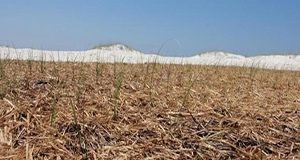Abstract
Perennial coastal grasses such as sea oats have long been recognized as the biological engineers of our increasingly stressed beaches and coastal dunes. Sea oats build dunes by capturing blowing sand and stabilizing it, and they’re often planted after dunes have been eroded, fragmented, or destroyed. Managers have tried commercial fertilizers and water-absorbing gels to ensure planted sea oats survive and thrive, but these products are not always effective and can be expensive. Removal of natural beach litter, called “wrack” and defined as “algae, grasses, driftwood, fruits, seeds, and carrion, along with cultural litter,” has frequently had the undesired effect of weakening the establishment and growth of sea oats. A relatively cheap and effective method to restore them is to reproduce the beneficial effects of this beach litter with “surrogate wrack.” This 4-page fact sheet describes the promising results of a study into the feasibility and effectiveness of surrogate wrack to help sea oats become established and grow more quickly and vibrantly to restore dunes and beaches. Written by Natalie Hooton, Debbie Miller, Mack Thetford, and Sean Claypool, and published by the Department of Wildlife Ecology and Conservation, August 2016.
WEC364/UW409: Building Coastal Dunes with Sea Oats and Surrogate Wrack (ufl.edu)
References
Hooton N., D. L. Miller, M. Thetford, and B. S. Claypool. 2014. "Survival and growth of planted Uniola paniculata and dune building using surrogate wrack on Perdido Key Florida, U.S.A." Restoration Ecology 22(5) 710-707. https://doi.org/10.1111/rec.12129
Dugan, J. E., D. M. Hubbard, M. D. McCrary, and M. O. Pierson. 2003. "The response of macrofauna communities and shorebirds to macrophyte wrack subsidies on exposed sandy beaches of southern California." Estuarine, Coastal and Shelf Science 58S:25-40. https://doi.org/10.1016/S0272-7714(03)00045-3
Nordstrom, K. F., N. L. Jackson, K. H. Korotky, and J. A. Puleo. 2011. "Aeolian transport rates across raked and unraked beaches on a developed coast." Earth Surface Processes and Landforms DOI: 10.1002/esp.2105 https://doi.org/10.1002/esp.2105
Orr, M., M. Zimmer, D. E. Jelinski, and M. Mews. 2005. "Wrack deposition on different beach types: spatial and temporal variation in the pattern of subsidy." Ecology 86:1496-1507. https://doi.org/10.1890/04-1486
Williams, A. M. and Feagin, R. A. 2010. "Sargassum as a natural solution to enhance dune plant growth." Environmental Management 46: 738-747. https://doi.org/10.1007/s00267-010-9558-3

